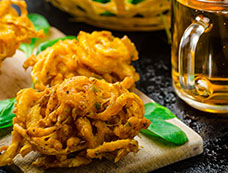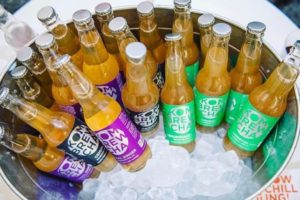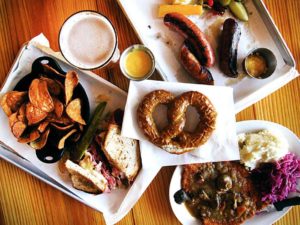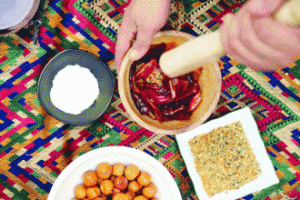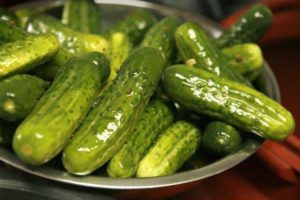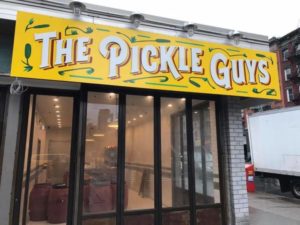Helmed by Gary and Libby Leybman, the eatery has been bouncing between farmers markets while a brick-and-mortar location in Walnut Hills is under construction.
By MADGE MARIL – CityBeat
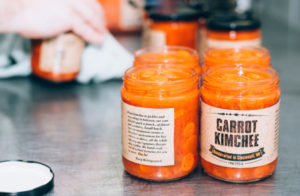
The Pickled Pig offers a variety of fermented veggies, including three types of kimchee.
PHOTO: PHIL HEIDENREICH
I didn’t get along with pickles. I didn’t like them; I didn’t trust them. I picked them off my burgers. I created tiny napkin walls between them and my french fries at restaurants. So when I first caught wind of local food fermenter The Pickled Pig, by name alone I chalked it up as edibles I would never experience.
Fortunately, I am an idiot often proven wrong. After one bite of The Pickled Pig’s sour pickle, my world was rocked forevermore.
The Pickled Pig took me by surprise at the Northside farmers market. When I visited the market on a dreary Wednesday afternoon, one of the owners of The Pickled Pig, Gary Leybman (co-owner with his wife Libby), had set up shop next to rows of vegetables and fresh-baked breads. While Leybman’s brick-and-mortar location in Walnut Hills is under construction, The Pickled Pig thrives on farmers markets, bouncing between Northside, Madeira, Anderson and, of course, Findlay, all year long.
At a farmers market, it’s usually the best practice to go to the booth where everyone else is going. While I browsed, an older gentleman walked up to The Pickled Pig, announcing, “I need the beets!”
He meant, of course, The Pickled Pig’s garlic beets. To inspire that amount of passion in a man over beets is admirable, a true feat in a world that doesn’t give proper respect to fermented vegetables.
Opting to go into business fermenting vegetables might seem like an odd choice, but for Leybman, the journey makes sense. Before he began The Pickled Pig, he was a private chef for more than a decade, working in kitchens as varied as The Celestial, Pho Paris, Daveed’s and at Saint Xavier church cooking for the priests.
“I wanted my own business, but I didn’t want a restaurant,” he says.
He learned how to make his most popular product — kimchee — in one of those aforementioned eateries, Daveed’s. An item rarely spotted outside of Korean restaurants or groceries, kimchee is a fermented vegetable side dish, generally involving cabbage. The restaurant had featured kimchee on a rotating menu just long enough for Leybman to learn how to make it.
“As soon as I was good at it, they took it off the menu!” he says. So he went home and made it for himself, expanding on the flavor profile he learned at work.
The Pickled Pig’s Napa Kimchee blends ginger, garlic and Korean chili with the classic fermented taste — not too sweet, not too sour. They also offer carrot kimchee and kimchee pickles.
Learning and loving the process behind producing kimchee inspired Leybman to ferment his backyard garden. From that first kimchee has stemmed garlic beets, sauerkraut, curried cauliflower and, yes, lots and lots of pickles.
I hadn’t had a pickle since the age of 5, when I bit into a vinegary one that had been sitting in the back of my parents’ fridge in one of those huge jars. When Leybman passed me one of his sour pickles, I felt my 5-year-old-self yell, “Don’t do it!” But I did it. And thank goodness I did. These pickles are nothing like the ones you buy at a supermarket or those relegated to the side of your plate at a burger restaurant. This sour pickle still had a snap of freshness to it — and a crunch.
“They say a good pickle should be audible from 10 paces away,” Leybman informed me as I (loudly) finished the pickle.
Besides being delicious, The Pickled Pig’s ferments are heavy in probiotics. Similar to yogurt, the fermented veggies are full of live bacteria, which popular science agrees aids in digestion. While probiotics occur naturally in the body, introducing them through ferments can help balance your system and reintroduce good bacteria into the gut. Basically, this food is so good that it’s good for you.
The flavors of Leybman’s past also color the dishes he offers. Leybman immigrated to Cincinnati from Belarus in Eastern Europe as a refugee because the government wouldn’t allow his family to practice Judaism.
He describes the Jewish people leaving Belarus as an exodus. There were two waves during the collapse of the Soviet Union; Leybman’s family immigrated during the second wave. He went through Austria and Italy, helped along by the kindness of other Jewish families.
His family’s plan was to immigrate to Philadelphia. But in Italy, none of the Jewish refugees spoke English.
“We had to file immigration paperwork, and everyone was just copying one another’s answers, right?” he says. “My parents copied down ‘Cincinnati’ instead of ‘Philadelphia’ after reading the English off someone else’s papers. So we came here by mistake.”
Now, Leybman smiles as he tells his family’s story. “Kind of a large mistake. But it really worked out.
“This,” he says as he places a hand on a jar of the garlic beets, “tastes like home.”
The Pickled Pig is now Leybman’s full-time job. While he sells his products in farmers markets around Cincinnati, they are also being snatched up by vendors like Jungle Jim’s. When negotiating how much of his fermented vegetables and pickles Leybman should bring to sell through Jungle Jim’s, they told him to “bring it all.” And so he did, and then went back to the kitchen to make some more.
In pursuit of his dream of opening a brick-and-mortar, Leybman turned to the community he knew and loved and created a Kickstarter in the hopes of funding the storefront.
Cincinnati replied, loudly: 252 backers pledged more than $15,000. Thanks to the community support, Leybman was able to purchase a space in Walnut Hills, which is slated to open in about a year.
The space will operate as a storefront and deli, featuring The Pickled Pig products and smoked meats — another hobby of Leybman’s. But if you can’t wait to try The Pickled Pig’s wider menu, they are available for catering — anything from smaller groups to parties of 200.
As The Pickled Pig grows, visit its website to see where it’ll be each week. Chances are, it’s a farmer’s market near you.
For more on THE PICKLED PIG, visit smokedandpickled.com.

